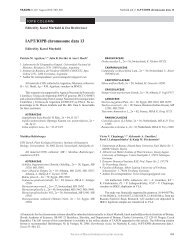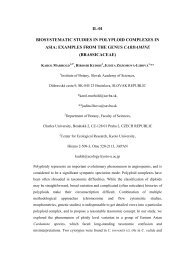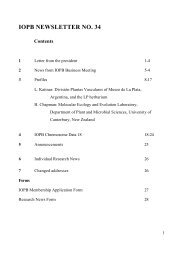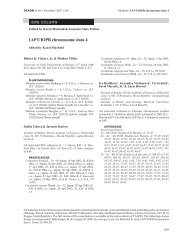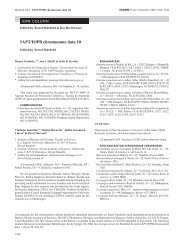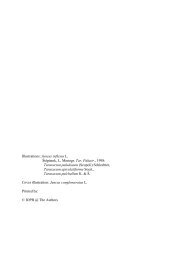CONTENS - International Organization of Plant Biosystematists
CONTENS - International Organization of Plant Biosystematists
CONTENS - International Organization of Plant Biosystematists
You also want an ePaper? Increase the reach of your titles
YUMPU automatically turns print PDFs into web optimized ePapers that Google loves.
O 15<br />
Evolving towards the tops: phylogeny and evolution <strong>of</strong> the<br />
European endemic Phyteuma (Campanulaceae)<br />
Gerald M. Schneeweiss 1 , Michael Barfuss 2 , Mike Thiv 3<br />
1 Department <strong>of</strong> Biogeography and Botanical Garden, University <strong>of</strong> Vienna, Rennweg<br />
14, A-103 Vienna<br />
2 Department <strong>of</strong> Systematic and Evolutionary Botany, University <strong>of</strong> Vienna, Rennweg<br />
14, A-103 Vienna<br />
3 Department <strong>of</strong> Botany, Federal Natural History Museum Stuttgart, Rosenstein 1, D-<br />
70191 Stuttgart<br />
Phyteuma comprises c. 20 species endemic to Europe and is morphologically<br />
characterized by its peculiar flower morphology with long and narrow corolla lobes<br />
remaining attached distally and separating only late in anthesis. Phyteuma species<br />
occur in different habitats, ranging from lowland woodlands via mid-elevation rock<br />
crevices to alpine grasslands and subnival tundra, rendering it a good model system<br />
to investigate habitat evolution in a comprehensive phylogenetic context. To this end,<br />
we established a sound hypothesis on the relationships among all Phyteuma species<br />
based on phylogenetic analysis <strong>of</strong> 4.3 kb sequence data from the plastid (trnL-intron<br />
and trnL-trnF spacer, trnK-intron including the matK gene) and the nuclear genome<br />
(ITS). Phyteuma is a well supported monophyletic group and is sister to the SE<br />
Alpine endemic Physoplexis. Within Phyteuma, two clades are found, largely<br />
corresponding to previously recognized sections, which were delimited by the<br />
distribution <strong>of</strong> different inflorescence types (spikes vs. capitulae). The majority <strong>of</strong><br />
currently recognized species are confirmed as separate lineages, while in others,<br />
most notably Ph. globulariifolium and Ph. scheuchzeri, current taxonomy does not<br />
adequately reflect lineage diversity. Using this phylogenetic framework, habitat<br />
evolution is analyzed under the assumptions that habitat evolution correlates either<br />
with the amount <strong>of</strong> molecular evolution (phylogram branch lengths) or with time<br />
(branch length <strong>of</strong> an ultrametric tree). Although the morphologically more primitive<br />
taxa occur in woodlands, there is no evidence that this habitat was the ancestral one<br />
for the genus, but rather the ancestor <strong>of</strong> Phyteuma was a chasmophyte,<br />
alpine/subnival habitats being clearly derived.<br />
16



